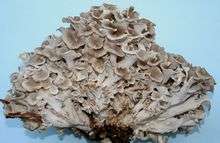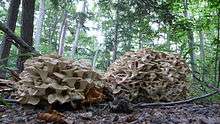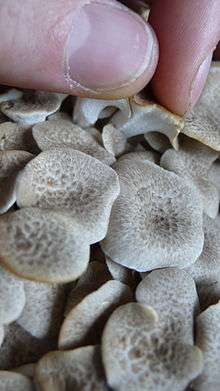Polyporus umbellatus
| Polyporus umbellatus | |
|---|---|
 | |
| Polyporus umbellatus | |
| Scientific classification | |
| Kingdom: | Fungi |
| Division: | Basidiomycota |
| Class: | Agaricomycetes |
| Order: | Polyporales |
| Family: | Polyporaceae |
| Genus: | Polyporus |
| Species: | P. umbellatus |
| Binomial name | |
| Polyporus umbellatus | |
Polyporus umbellatus is a rare, edible species of mushroom, found growing on roots of old beeches or oak (e.g.[1]). It is also called lumpy bracket and umbrella polypore.
Description
The fruit body is composed of numerous (sometimes several hundred) caps. They are 1–4 cm in diameter, deeply umbilicate, light brown, and form the extremities of a strong, many branched stalk. The compound fungus can be up to 40 cm in diameter. The pores are narrow and white. The stalk is whitish grey, and originates from a strong, tuber-like nodule that is underground. The flesh is white, rather soft when young, although hardens with age.

Edibility and cooking
Choice edible. Fantastic fried in butter or olive oil on medium heat. Very savory. Great with meats and starches.
Bioactive compounds
Polyporus umbellatus may contain bioactive compounds with immunostimulating, anticancer, anti-inflammatory, and hepatoprotective properties.[2][3][4][5][6][7][8][9]


References
- ↑ Kunca V., 2011: Ecology and incidence of Polyporus umbellatus in Slovakia. Czech Mycology 63(1): 39-53.
- ↑ Li X, Xu W, Chen J (2010). "Polysaccharide purified from Polyporus umbellatus (Per) Fr induces the activation and maturation of murine bone-derived dendritic cells via toll-like receptor 4". Cell Immunol. 265 (1): 50–6. doi:10.1016/j.cellimm.2010.07.002. PMID 20673883.
- ↑ Zhao YY, Chao X, Zhang Y, Lin RC, Sun WJ (2010). "Cytotoxic Steroids from Polyporus umbellatus". Planta Med. 76 (15): 1755–8. doi:10.1055/s-0030-1249926. PMID 20458671.
- ↑ Sun Y, Yasukawa K (2008). "New anti-inflammatory ergostane-type ecdysteroids from the sclerotium of Polyporus umbellatus". Bioorg Med Chem Lett. 18 (11): 3417–20. doi:10.1016/j.bmcl.2008.04.008. PMID 18439824.
- ↑ Zhou WW, Lin WH, Guo SX (2007). "Two new polyporusterones isolated from the sclerotia of Polyporus umbellatus". Chem Pharm Bull. 55 (8): 1148–50. doi:10.1248/cpb.55.1148. PMID 17666835.
- ↑ You JS, Hau DM, Chen KT, Huang HF (1994). "Combined effects of chuling (Polyporus umbellatus) extract and mitomycin C on experimental liver cancer". Am J Chin Med. 22 (1): 19–28. doi:10.1142/S0192415X94000048. PMID 8030616.
- ↑ Ohsawa T, Yukawa M, Takao C, Murayama M, Bando H (1992). "Studies on constituents of fruit body of Polyporus umbellatus and their cytotoxic activity". Chem Pharm Bull. 40 (1): 143–7. doi:10.1248/cpb.40.143. PMID 1576664.
- ↑ Zhang YH, Liu YL, Yan SC (1991). "[Effect of Polyporus umbellatus polysaccharide on function of macrophages in the peritoneal cavities of mice with liver lesions]". Zhong Xi Yi Jie He Za Zhi. 11 (4): 225–6, 198. PMID 1773459.
- ↑ Lin YF, Wu GL (1988). "[Protective effect of Polyporus umbellatus polysaccharide on toxic hepatitis in mice]". Zhongguo Yao Li Xue Bao. 9 (4): 345–8. PMID 3195347.